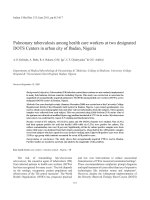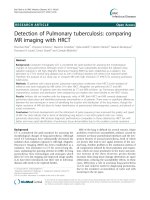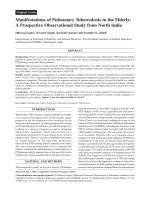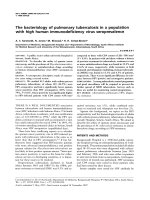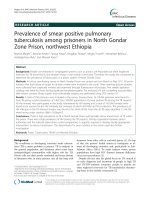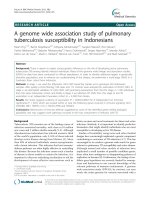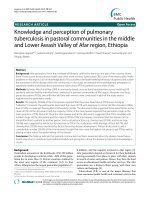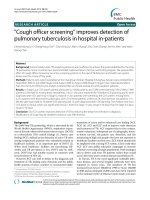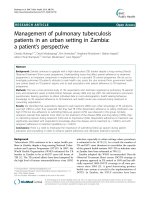PREVALENCE OF PULMONARY TUBERCULOSIS AMONG DIABETICS pot
Bạn đang xem bản rút gọn của tài liệu. Xem và tải ngay bản đầy đủ của tài liệu tại đây (110.34 KB, 6 trang )
Biomedica Vol. 20 (Jul. – Dec, 2004)
PREVALENCE OF PULMONARY TUBERCULOSIS
AMONG DIABETICS
A. QAYYUM, M. SHAFIQ AND AZFAR FAROGH
Department of Medicine, Quaid-e-Azam Medical College / B. V. Hospital, Bahawalpur
This study was performed in the department of medicine, B. V. Hospital, Bahawalpur, Pakistan,
between January 2001 and December 2001. Prevalence of pulmonary tuberculosis in 100 dia-
betic patients admitted consecutively in medical wards was calculated and compared with 100
non diabetic controls admitted consecutively during the same period. In this study the calcu-
lated prevalence of pulmonary tuberculosis among diabetic patients was 9.5% compared to
non-diabetic patients who had prevalence of 2.08% (P-Value<. 002) indicating 7.5% higher risk
in diabetic patients. The purpose of this study was found out the prevalence of pulmonary tuber-
culosis among patients with tuberculosis.
Key Words: pulmonary tuberculosis. Diabetes mellitus. Tuberculosis and Diabetic Prevalence.
INTRODUCTION
Tuberculosis is at least as old as mankind and my-
cobacteria are believed to be amongst the oldest
bacteria on earth. Tuberculosis causes approxi-
mately 6% of all deaths world wide
1
. According to
conservative estimates around 2 million new cases
of tuberculosis are seen each year. The total num-
ber of cases of tuberculosis in the world are placed
at 15-20 million. The disease is on the rise and
available statistics with WHO show that annual
incidence of tuberculosis may reach 300 per
100,000 inhabitants in parts of Asia
2
. Data of
prevalence of tuberculosis in Pakistan is available
from two surveys conducted by the Government of
Pakistan and WHO in 1960-61 and 1977-78. On
the basis of tuberculin reaction of 10mm +, the
first survey reported the prevalence rate of 54.7%
whereas the second study reported a figure of
54.4%.
Based on tuberculin reaction of 10mm + the
reported number of new cases of tuberculosis in
Pakistan are 1.6 million per year
3
. Diabetic
patients have an increased propensity to acquire
infection particularly of tuberculosis and fungus.
Their frequency is reported to be four times higher
than in non-diabetic patients
4
. The frequency of
pulmonary tuberculosis in another study was 10
times higher among diabetic patients
5
. Diabetics
the prevalence of diabetes has been shown to
increase in the developing countries as they are
being westernised
6
. The estimated prevalence of
diabetes mellitus in Pakistan is 8%. There are at
present at least 10 million diabetics in the world
7
.
A study conducted in 1995, found the coexist-
ing prevalence of diabetes mellitus and pulmonary
tuberculosis in Pakistan as 19.8%
8
. Another study
conducted in Dakota reported that tuberculosis
was more commonly seen in elderly diabetics i.e.
more favorable course and outcome of tuberculosis
seen in IDDM than in NIDDM. This can be related
to younger age and early diagnosis of tuberculosis
in IDDM patients
9
.
Other studies have shown that patients having
higher glycosylated haemoglobin have more seri-
ous intoxication, more advanced disease, more
prone to destruction, discharge bacteria more fre-
quently and are more resistant to treatment. In
diabetes the complications are significantly related
to hyperglycaemia. Patients with good metabolic
control have fewer complications compared to
patient having poor control
10
. Strict plasma
glucose control is being important for the preven-
tion as well as avoidance of complications in
diabetic patients
10
. Tuberculosis is the ninth most
frequent cause of death in Africa
11
. A study
performed in Taiwan revealed there was a higher
incidence of pulmonary tuberculosis in elderly
diabetic patients
12
.
MATERIAL AND METHODS
A total of 200 patients were selected and they were
divided into two groups:
Group 1: included diabetic patients admitted to
the hospital for any reason.
Group 2: comprised of non-diabetic patients
admitted to B.V hospital, Bahawalpur
during the same period for any reason.
Blood samples were taken from veins
without stasis and frothing and sent to
the central laboratory of B.V Hospital
74
A. QAYYUM, M. SHAFIQ AND AZFAR FAROGH
Biomedica Vol. 20 (Jul. – Dec, 2004)
within half an hour, for glucose estima-
tion. Analysis of plasma was performed
by oxidase method at 500nm on spec-
trophotometer. The diagnosis of diabe-
tes mellitus was based on the following
criteria;
(a) Symptomatic Patients
Single fasting plasma glucose > 7.8mmol/L.
Or random plasma glucose > 11.1mmol/L was
considered diagnostic
15
.
(b) Asymptomatic Patients
Criteria for the diagnosis were the same but
second confirmatory test was performed
15
.
Diagnosis of Pulmonary Tuberculosis
For the diagnosis of pulmonary tuberculosis
sputum samples were collected, before starting
anti-tuberculosis treatment, in 50ml plastic jars
with screw caps. Three to five consecutive early
morning sputum samples were sent to the Central
Laboratory of BV hospital within one hour after
collection. Zeil Neelson staining of sputum smears
was carried out in the laboratory. The reporting of
smears was based on the following criteria
22
.
Culture of Mycobaterium Tuberculosis
Sputum samples were homogenized in the micro-
biology laboratory with N-acetylcestein. Decon-
tamination of samples was carried out with 4%
sodium hydroxide. Later on pH of the samples was
made neutral. Cultures were inoculated on
Lowen – stein Jensen medium. Reports were
collected 6 weeks later
22
, The diagnosis of pulmo-
nary tuberculosis was based on the following crite-
ria
13,14,23
.
1. Sputum smear positive (3-10 bacilli per slide
or more) for acid – fast bacilli at least twice.
Sputum Smears Reporting Criteria
No. of Bacilli Report
0 No acid fast seen
1-2 per slide Repeat specimen
3-9 per slide + positive
10 or more per slide ++ positive
1 or more per field +++ positive
2. Sputum smear positive (3-10 bacilli per slide
or more) for acid – fast bacilli at least twice.
3. Positive sputum culture for Mycobacterium
tuberculosis once.
4. Sputum smear positive once (3-10 bacilli per
slide or more) typical symptoms of tuber-culo-
sis in the form of low grade fever for more
than one week, cough for more than four
weeks and chest X-ray showing cavitatory
lesions or consolidation in any of the lobes of
the lungs.
Exclusion Criteria
Patients, having risk factors for tuberculosis
other than diabetes mellitus, were excluded on the
basis of history, physical examination and neces-
sary investigations. And those factors were; silico-
sis, gastrectomy, ileal bypass, chronic renal failure,
high dose corticosteriods, cytotoxic drugs, HIV
infection, lymphoma, leukaemia, alcoholism and
malnutrition.
Study Groups
Group-I (diabetics)
A total of 100 diabetic patients were enrolled in
this group and 5 patients were excluded because
they did not fulfil the diagnostic criteria of pulmo-
nary tuberculosis (table 1).
GROUP-II (Non-Diabetic)
The 100 non-diabetic matched controls were
enrolled in this group and 4 were excluded because
they were unable to fulfill the selection criteria
(table 2).
Table 1: Study Group-I.
Total patients enrolled 100
Patients excluded from study 05
Remaining patients 95
Male 60
Female 35
Table 2: Study Group-II.
Total patients enrolled 100
Patients excluded from study 04
Remaining patients 96
Male 60
Female 36
PREVALENCE OF PULMONARY TUBERCULOSIS IN DIABETICS
75
Biomedica Vol. 20 (Jul. – Dec, 2004)
RESULTS
In both groups the results of 191 patients were
analysed. Results of our study were of statistical
significance although our study groups contained a
small number of patients. By using student T-test
the statistical significance of prevalence of pulmo-
nary tuberculosis in diabetics was calculated and
the P value was found to be 0.002, which statisti-
cally is significant.
Prevalence of Pulmonary Tuberculosis
Group-I (table 3)
Prevalence of pulmonary tuberculosis in diabetics:
Total number of patients having diabeties and
pulmonary tuberculosis = 9.
Total diabetic patients = 95.
Prevalence = 9.5%.
Table 3: Prevalence of pulmonary tuberculosis
in diabetics.
Total diabetic patients 95
Total patients with pulmonary tubercu-
losis
9
Prevalence of pulmonary tuberculosis 9.5%
Group-II (table 4)
Prevalence of pulmonary tuberculosis in Non-
diabetics:
Total number of patients in study group-II
(Non-diabetics) = 96.
Total number of Patients with pulmonary
tuberculosis in group-II = 2.
Prevalence = 2.08%.
Table 4: Prevalence of pulmonary tuberculosis
in Group-II.
Total patient with tuberculosis 96
Total patients in group-II 02
Prevalence of tuberculosis 2.08%
Table 5: Age grouping in diabetics.
Ages groups (years) No. of patients
Third decade (20-29) 11
Fourth decade (30-39) 17
Fifth decade (40-49) 25
Sixth decade(50-59) 40
Seventh decade(60-69) 02
Eighth decade (70-79) 0
Table 6: Age distribution in diabetic tubercu-
lous patients.
Total patients 9
Patients in 4
th
& 5
th
decade 7
Patients in 3
rd
decade 2
Distribution of Age
Group-I (Diabetic Patients)
Age range was from 20-60 years but 68.42%
patients were in 4
th
and 5
th
decade of life. Out of 9
patients having pulmonary tuberculosis 2 were in
the 3rd decade (22-27) and rest of the 7 were in 4
th
and 5
Th
decades (table 5 and 6).
Group-II (Non-diabetic patients)
In the control group again the same age group
people were selected, 67.70% patients were in 4
th
and 5
th
decade of life. Out of 96 patients two
patients had pulmonary tuberculosis, one was 20
years old and the other was 50 years old
(table 7, 8).
Table 7: Age grouping in non-diabetics.
Age groups (years) No. of Patients
3
rd
Decade (20-29) 11
4
th
Decade (30-39) 17
5
th
Decade (40-49) 25
6
th
Decade(50-59) 40
7
th
Decade(60-69) 02
8
th
Decade (70-79) 01
76
A. QAYYUM, M. SHAFIQ AND AZFAR FAROGH
Biomedica Vol. 20 (Jul. – Dec, 2004)
Table 8: Age distribution in non - diabetic
tuberculous patients.
Total patients 2
Patients in 5
th
decade 1
Patients in 3
rd
decade 1
Sex Distribution
Group-I
Among 95 patients 60 were males and 35 were
females. Only 9 patients had pulmonary tubercu-
losis out of which 7 were males and 2 were females
(table 9).
Group-II
In 96 patients 60 were males and 36 were females.
In this group only 3 patients had pulmonary tuber-
culosis 1 was male and the other was a female
(table 10).
Table 9: Sex distribution in tuberculous diabetic
group.
Sex Frequency Percent
Male 7 77.77
Female 2 22.22
Total 9 100
Table 10: Sex distribution in tuberculous non-
diabetic group
Sex Frequency Percent
Male 1 50
Female 1 50
Total 2 100
Distribution of Type I and
Type II Diabetics Mellitus
Among 95 diabetic patients, predominant group
had Type-II diabetes mellitus. Eighty patients
were with type-II diabetes mellitus (84.22%). Fif-
teen patients were with type-I diabetes mellitus
(15.78%) (Table 11).
Radiological Findings in Diabetics Group
Radiologically lower lobe involvement and multi-
lobe involvement, were the commonest presenta-
tions (Table 13).
Table 11: Distribution of type type-I and type II
diabetes mellitus in group-I.
Type of diabetes Frequency
Percent
Type-I 15 15.78
Type-II 80 84.21
Total 95 100
Table 12: Chest X-ray findings in tuberculosis
in diabetic patients.
Lung Lobe involved
Frequency
Percent
Upper lobe involve-
ment
2 22.22
Middle lobe involve-
ment
1 11.11
Lower lobe involve-
ment
3 33.33
Multilobe involvement 3 33.33
Total 9 100
DISCUSSION
Diabetes mellitus is a very common metabolic
condition and is one of the major disease affecting
people across all kinds of barriers. It is on the rise
everywhere in Pakistan.
In Pakistan both diabetes and pulmonary
tuberculosis are very common, we searched the
local literature but could not find any study into
the prevalence of pulmonary tuberculosis in dia-
betics however International studies were avail-
able for comparison. Regarding the prevalence of
tuberculosis in diabetic patients, different studies
have shown different results. One study performed
in Addis Ababa University Hospital showed 15.8%
prevalence of tuberculosis among diabetics
18
.
Another study showed the relative risk of
pulmonary tuberculosis among diabetics i.e 3-5
times higher than in the control group
71
.
In our
study the calculated prevalence of pulmonary
tuberculosis among diabetic patients was 9.5 %
compared with non-diabetic patients who had a
prevalence of 2-8% (p-value<.002) indicating 7.5%
higher risk in diabetic patients.
The present study shows higher prevalence
compared to the other studies, which may be
explained because of the higher prevalence of
tuberculosis in developing countries like Pakistan.
According to one of the WHO report on tuberculo-
sis presented in Geneva in 1997, each year 210,700
new cases of tuberculosis occur in Pakistan
20
. In
PREVALENCE OF PULMONARY TUBERCULOSIS IN DIABETICS
77
Biomedica Vol. 20 (Jul. – Dec, 2004)
an Ethiopian study the prevalence of tuberculosis
in diabetic males was 52.7% compared to 43.3% in
female diabetic patients. In our study 77.77% were
males and 22.22% were females in Group-I. This
sex difference may be due to less consultation, less
awareness and less education to our women.
In the diabetic group with pulmonary tubercu-
losis 7/9 (77.77%) of our patients were in their 4
th
and 5
th
decade of life while 2/9(22.22 %) were in
the 3
rd
decade. The age range in different studies
was the same
16-18
. In our study we have observed
that clinical and radiological features of tuberculo-
sis in diabetics have a different pattern compared
with a matched control. Radiologically apices are
commonly involved in pulmonary tuberculosis in
non-diabetics. In our study of diabetic group
bilateral involvement was found in 44.44%, lower
lobe in 33.33%, upper lobes in 22.22% and middle
lobes in 11.11%. The lower lobe involvement in
diabetic patients has been shown in different
studies
19,21
.
The aim of our study was to find the preva-
lence of pulmonary tuberculosis among diabetic
patients admitted to medical wards of B.V.
Hospital Bahawalpur, which is a teaching hospital
affiliated with Quaid-e-Azam Medical College,
Bahawalpur. The association between diabetes
mellitus and pulmonary tuberculosis emphasises
that this group should be a target for tuberculosis
screening.
CONCLUSION
The prevalence of pulmonary tuberculosis among
diabetic patients is higher than non-diabetic
patients admitted to B.V. Hospital, Bahawalpur.
The prevalence in male patients is higher than
female patients. The major group having pulmo-
nary tuberculosis with diabetes mellitus was in 4
th
and 5
th
decades of life. The major symptoms of
tuberculosis were fever, weight loss and cough.
The predominant signs in our study of pulmonary
tuberculosis in diabetics were coarse crepitations
and bronchial breathing. Radiologically bilateral
and lower lung field involvement was the
predominant finding. Our study may not get a high
statistical significance because of small number of
patients however this local data may help in a
future broad based studies.
REFERENCES
1. Ravilglon MC, O’ Brien RJ. Tuberculosis in: Fauce
AS, Braunwald, Isselacher KJ, Wilson JD, Martin
JB, Kaspr DL, Longo L. eds. Harrison’s Principles of
Internal Medicine. 14th edition. New York:
McGraw-Hill Companies, 1998: 1004-1014.
2. Yad I, Pathan AJ. In: Iliyas M. eds: Community
Medicine and Public Health 4 th edition. Karachi:
Time Reader, 1997: 544-45.
3. Yad I Pathan AJ Iliyas M.eds: Community medicine
and Public Health 4th edition. Karachi: Time
Reader 1997: 548-49.
4. Marvisi M, Marani G, Brianti M, Dela PR ,
Pulmonary complications of diabetes mellitus.
Recent progress in medicine 1996: 87 (11): 623-27.
5. Gary SM. In:Rom WN, Gary SM. eds. Tuberculosis
First edition, Boston, New York: Little Brown and
Company, 1996: 672-8.
6. Kerin o’ dea. Environmental factors in NIDDM.
Digest 1996 Mar; 9 (3): 1-15.
7. Zimmet P Globalization, Coca-Colanization and the
chronic disease epidemic: can the doomsday
scenario be averted. J Internal Medicine 2000,
March; 247 (3): 301-10.
8. Jawad F, Shera AS, Memon R Ansari G. Glucose
intolerance in pulmonary tuberculosis. JPMA-J Pak
Med- Assoc 1995 Sep: 45 (9): 237-38.
9. Morley JE. The elderly type-II diabetic patients:
special consideration. Diabetic Medicine 1998: 15
Suppl 4: S 41-6.
10. Hashim R, Khan AF, Khan AD, Shoukat A.
Prevalence of microvascular complications in
diabetic patient. JCPSP 1999 Mar; 9 (3) : 120-022.
11. Sidide EH. Main complication of diabetes mellitus
in Africa. Ann Med Intern 2000 Dec; 15 (8): 624-
28.
12. Liaw-YS, Yang PC; YU-CJ; WU-ZG, Chang-DB; Lee-
LN; Kuo-SH; LUL-KT: Clinical spectrum of
tuberculosis in older patients: J Am-Geriactric-Soc.
1995 March; 43(3): 256-60.
13. Harrues-AD, Mphasa-NB, Mundy-C, Benrjee-A,
Kwanjan JH, Sulanipoini-FM. Screening
tuberculosis suspects using two sputum smears.
Int-J-Tuberc-Lung-Dis 2000 Jan; 4 (1): 36-40.
14. Aris-EA, Bakari-M, Chonde-TMJ, Kitinya J,
Swai AB. Diagnosis of tuberculosis in sputum
negative patients in Dar es Salam. East Afr Med J
1999 Nov; 76 (111): 630-34.
15. Harrus MI, Zunnet P. Classification of Diabetes
Mellitus and other categories of Glucose Intolerence
In: Albert KGMM. Zimmet P, DeFranzo, Kee H. eds.
International Textbook of Diabetes Mellitus. 2
nd
edition. Chichester; Wiley, 1997: 9-23.
16. Kim SJ, Hong YP, Lew WJ, Yang Sc, Lee EG.
Incidence of pulmonary tuberculosis among
diabetic. Tuber Lung Dis 1995; 76(6): 529-33.
17. Kako K, Sakibarah H, Satoy M, Kamidaira M,
Suet S. Actual status of the management of
tuberculosis patients in university hospital without
isolation wards for infection diseases. Kakku 1997;
72(6): 395-401.
18. Felk Y, Abdulkadir J. Adraye G. Prevalence and
clinical features of tuberculosis patients. The role of
diabetes mellitus in the higher prevalence of
tuberculosis among Hispanics. East Adr Med L
1999 Jul; 76(7): 361-64.
19. Wilcke JT, Askgaard Ds, Nybo JB, Dossing M. The
radiographic spectrum of adult pulmonary
78
A. QAYYUM, M. SHAFIQ AND AZFAR FAROGH
Biomedica Vol. 20 (Jul. – Dec, 2004)
tuberculosis in a develop country Respir Med 1998
Mar; 92 (3): 493-97.
20. Gunzman CP, Cruz AT, Velarda HV, Vargas MP.
Progressive age related changes in pulmonary
tuberculosis. Images and the effect of diabetes
mellitus. AM J Respir Crit Care Med 2000; 162 (5):
173-40.
21. Kubam C, Fostin JG, Koulla SS, Akono MR. Lower
lung field tuberculosis in Younde, /Cameron Cent
Aft J Med 1996; 42 (3): 625.
22. Joklik WK, Wellet WP, Amos DB, Welfort CM. eds.
Zinssers Microbiology 20
th
Edition. Connecticut:
Appleton And Lange. 1992: 498-625.
23. Marciniuk DD, McNab DB, Martin WT,
Vernon H, Hoeppner. Detection of Pulmonary
Tuberculosis patients with a Normal chest
readiograph. Chest 1999; 115: 445-52.
